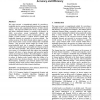Free Online Productivity Tools
i2Speak
i2Symbol
i2OCR
iTex2Img
iWeb2Print
iWeb2Shot
i2Type
iPdf2Split
iPdf2Merge
i2Bopomofo
i2Arabic
i2Style
i2Image
i2PDF
iLatex2Rtf
Sci2ools
SMA
2008
ACM
2008
ACM
Converting a tetrahedral mesh to a prism-tetrahedral hybrid mesh for FEM accuracy and efficiency
This paper presents a computational method for converting a tetrahedral mesh to a prism-tetrahedral hybrid mesh for improved solution accuracy and computational efficiency of finite element analysis. The proposed method inserts layers of prism elements and deletes tetrahedral elements in sweepable sub-domains, in which cross-sections remain topologically identical and geometrically similar along a certain sweeping path. The total number of finite elements is reduced because roughly three tetrahedral elements are converted to one prism element. The solution accuracy of the finite element analysis improves since a prism element yields a more accurate solution than a tetrahedral element. Only previously known method for creating such a prism-tetrahedral mesh was to manually decompose a target volume into sweepable and non-sweepable sub-volumes and mesh each sub-volume separately. The proposed method starts from a cross-section of a tetrahedral mesh and replaces the tetrahedral elements w...
| Added | 15 Dec 2010 |
| Updated | 15 Dec 2010 |
| Type | Journal |
| Year | 2008 |
| Where | SMA |
| Authors | Soji Yamakawa, Kenji Shimada |
Comments (0)

